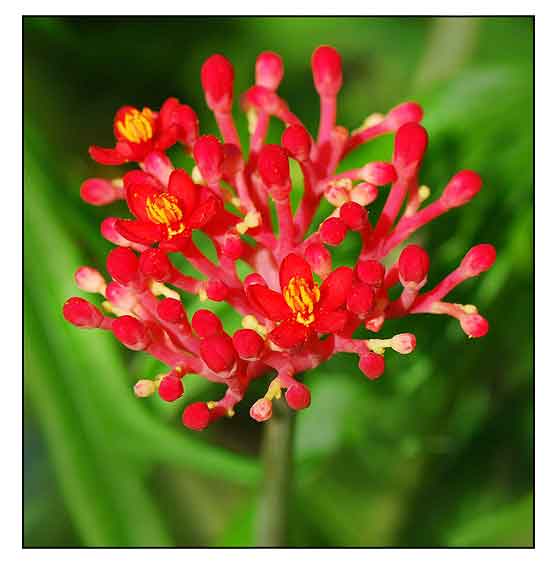 Gen info Gen info
- Jatropha is a genus of flowering plants in the spurge family, Euphorbiaceae.
- The genus name Jatropha derives from Greek words iatros, meaning 'physician', and trophe, meaning 'nutrition', hence the common name 'physic nut', a name shared with other genus members. The genus contains about 170 species of succulent plants, shrubs, and trees.
The species name multifida derives from Latin multi meaning many, and fidus meaning 'cleavage or divided' referring to the divided leaves.
- Because of the use of leaves and sap for wound healing, the plant has earned names such as yodium (iodine plant) and "betadine" leaves in Indonesia.
Botany
• Mana is a smooth shrub 2 to 3 meters high, with the petioles as long as the leaves. Leaves are glaucous beneath, 15 to 30 centimeters in diameter, and cleft nearly to the base into about 10 lanceolate, entire or pinnately incised lobes, the lobes about 1 to 4 centimeters wide. Flowers are red, borne on long peduncled cymes, 3 to 6 centimeters broad. Capsules are obovoid, about 2 centimeters long, somewhat three-angled, with the angles rounded.
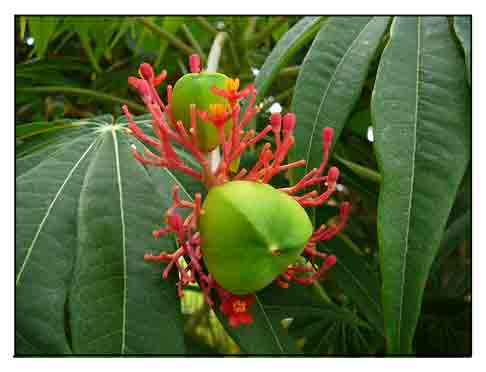 • A perennial shrub 1-5 m high. Foliage: Large, palmately cut into 9-11 deep narrow lobes., up to 30cm across. Flowers: Borne in clusters, flowers are bright coral red with small yellow petals, resemble a piece of coral. Fruit: Green to yellow when matured, usually 3 angled capsule. The capsule does not open on its own at maturity like some of other Jatropha species do. (27) • A perennial shrub 1-5 m high. Foliage: Large, palmately cut into 9-11 deep narrow lobes., up to 30cm across. Flowers: Borne in clusters, flowers are bright coral red with small yellow petals, resemble a piece of coral. Fruit: Green to yellow when matured, usually 3 angled capsule. The capsule does not open on its own at maturity like some of other Jatropha species do. (27)
Distribution
- Introduced from tropical America.
- Not naturalized.
-
Ornamental cultivation. The inflorescences often in great demand by florists for making red corsages.
- Planted as a hedge.
- Native to Cuba, Dominican Republic, Haiti, Leeward Is., Mexico Gulf, Mexico Northeast, Mexico Southwest, Puerto Rico, Southwest Caribbean, Trinidad-Tobago, Windward Is.
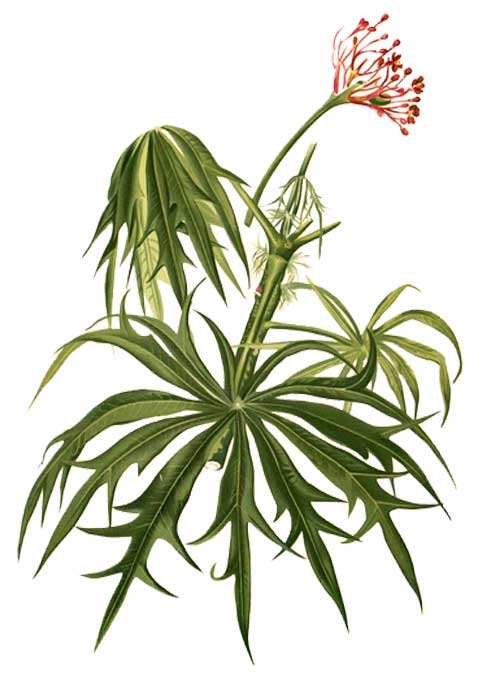 Constituents Constituents
- Seeds contain 6% glucose, 1% bitter principle, 30% fixed oil. The latter turns vermillon with sulfuric acid.
- Seed oil is similar to Jatropha curcas.
- Leaves contain saponin.
- Phytochemical analysis of root bark extract yielded alkaloids, tannins, glycosides, saponins, and flavonoids. (See study below)
(10)
- An immunologically active novel cyclic decapeptide, Labaditin, consisting of 1 Ala, 2 Gly, 1 Ile, 2 Thr, 2 Trp, and 2 Val, was isolated from the the latex.
(11)
- Sap yielded alkaloids, saponin, carbohydrate, phenol and tannins, with the absence of glycosides, flavonoids, and steroid.
(12)
- Study of methanolic stem bark extract yielded three metabolites, microcyclic lathyrane diterpenoids (1-3). (see study below) (13)
- An ethyl acetate extract of leaves yielded two C-glycosyl flavones viz. vitexin (1) and isovitexin (2). (see study below) (18)
- Study isolated Labaditin, an immunologically active novel cyclic decapeptide, consisting of 1 Ala, 2 Gly, 1 Ile, 2 Thr, 2 Trp and 2 Val, has been isolated from the latex of Jatropha multifida L. (22)
- Leaves of J. multifida yielded flavones apigenin, acacetin and luteolin; phenolic acids such as vanillic, syringic, p-OH- benzoic acid, melilotic, cis- and trans-ferulic; p-coumaric and phloretic acids, tannins, proanthocyanidins and glycoflavones. (25)
- Study of roots isolated a new long chain, multifidione (1), along with seven known lathyrane-type diterpenes, 15-epi-4Z-jatrogrossidentadion (2), 4Z-jatrogrossidentadion (3), 2-epi-hydroxy isojatrogrossidentadion (4), 2-hydroxyisojatrogrossidentadion (5), 4E-jatrogrossidentadion (6), 15-epi-4E-jatrogrossidentadion (7), and jatrogrossidion (8). (see study below) (30)
- Phytochemical screening of leaves yielded flavonoids, tannins, alkaloids, anthocyanins, mucilages, leuco-anthocyanins, and saponosides. (see study below) (38)
- Nine new macrocyclic diterpenoids (1-9), jatromultones A-I, along with eight analogues (10-17) were isolated from the trunks of J. multifida. (see study below) (40)
- Study isolated nine diterpenoids (1-9), including a new jatromulone A, four podocarpane diterpenoids (2-5), two lathyrane-type diterpenoids (6,7) and two dinorditerpenoids (8,9). (see study below) (43)
- Study evaluated methanol extract "betadine" leaves
by GC-MS detected 27 peaks of compounds, the three most dominant of which showed retention times of 18,072, 19,950, and 20,058, namely
9-hexadecanoic, methyl ester, (Z)-; 7-hexadecanoic acid, methyl ester, (Z)-; Methyl hexadec-9-enoate; 9,12,15-octadecatrienoic acid, methyl ester, (Z,Z,Z)-; and Phytol. (45)
Properties
- When wounded, the plant exudes a milky juice.
-
Seeds are poisonous, cathartic, emetic.
- Oil is also reported as emetic and purgative.
- Studies have suggested antimicrobial, anti-complement, anti-candida, anti-melanin deposition, hemostatic, wound healing, anti-inflammatory, analgesic, anti-leiishmanial, antifungal, larvicidal, antitubercular, larvicidal, hypotensive, cytotoxicity, molluscicidal, anti-influenza, anti-herpes virus, hemostatic, anti-biofilm, thioredoxin reductase inhibitory activities
Parts used
Sap, leaves, roots, seeds, oil.
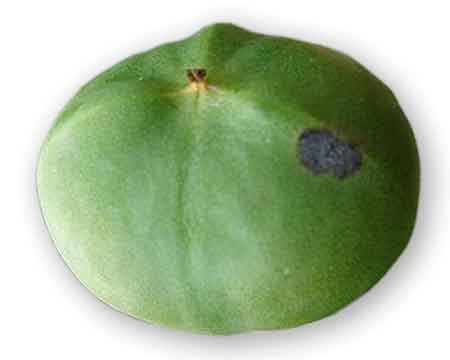 Uses Uses
Edibility
- Tuberous roots can be eaten after roasting.
Folkloric
- In French Guiana, seeds are used fresh as purgative and emetic.
- In Indo-China, decoction of dried roots used for indigestion and colic. Also, prescribed as tonic, for orchitis, and for edema. Leaves are used for scabies; the latex applied to wounds and ulcers.
- Bark and leaves used for skin diseases, eczema, and itching.
-
Oil used internally and externally as abortifacient.
- Oil is also emetic and purgative.
- A single seed acts as emeto-cathartic.
 -
Lime juice and stimulants are suggested antidotes for seed poisoning. -
Lime juice and stimulants are suggested antidotes for seed poisoning.
- In Nigeria, leaf juice extract used for treatment of thrush. Leaves and leaf sap used as purgative. Leaves and fruits are boiled, used internally or externally in a bath for fever. Poultice of root bark and roots used as wound dressing. Roots, taken internally, for worms and gonorrhea. Latex used for wounds and skin infections.
- In Benin, sap used to stop external bleeding.
- In New Caledonia, seeds used as abortifacient. (24)
- In African folk medicine, used for the treatment of pain, infection, inflammatory conditions, tumors.
- Latex used for treatment of infected wounds, ulcers, skin infections, scabies. Sometimes referred to as betadine plant. In Indonesia, called yodium (iodine), referring to its popular use as a wound healing remedy.
Others
- Decorative: Red flowers in demand by florists for making beautiful red corsages.
- Poison: Plant used as fish poison.
- Illuminant: Oil used for illuminating purposes.
- Agroforestry: Ornamental cultivation for foliage and flowers. Often grown in hedges.
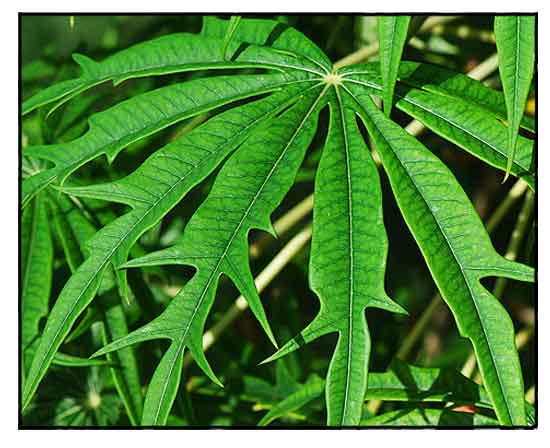 Toxicity / Poisoning Toxicity / Poisoning
- Seeds are poisonous. Once they were considered an energetic and dangerous cathartic. A single seed is effective as emeto-cathartic. Its use has been abandoned in many native medical systems. Lime juice and stimulants are reported best antidotes to seed poisoning.
- Curcin and Ricin: Seeds, fruit and sap contain a chemical called curcin which causes symptoms when ingested. A single seed can cause symptoms in children. Jatropha species contain the toxalbumin ricin which can cause severe vomiting and diarrhea, dehydration, shock,, renal and hepatic impairment. Ricin also has cardiotoxic, hemolytic effects, and deaths have been reported. (3)
- Case report of Jatropha multifida intoxication in two children: Two children were admitted after ingestion of a large amount of Jatropha multifida fruits, presenting with mental obtundation, vomiting and dehydration. Treatment consisted of intravenous fluid replacement and electrolyte replacement and urine alkalinization. (3)
- Poisoning Resembling Organophosphate Intoxication: Four siblings presented with vomiting, diarrhea and miosis following ingestion of J multifida. The clinical presentation warranted the consideration of organophosphate ingestion in the differential diagnosis. Treatment of Jatropha intoxication is supportive with emphasis of rehydration. Measurement of plasma acetylcholinesterase activity levels, which is normal after Jatropha ingestion and decreased following organophosphate poisoning, may help differentiate between the two. (4)
Studies
• Oral Candidiasis: Study compared the efficacy of Jatropha multifida in the management of oral candidiasis compared to oral Nystatin. The juice extracts from J multifida leaves were applied to the tongue and oral mucosa of affected children as a single application. Results showed JM to be efficacious in the treatment of oral candidiasis, with the advantages of acting faster (clearing of lesions noted within 24 hours compared to Nystatin at 48 hours) and and in its efficacy as a single dose. It presents as an alternative in third world countries where it is easily cultivated and accessible. (1)
• Anti-Complement / Latex: Study isolated and characterized the anti-complement constituent(s) in the latex of J multifida to explain the use traditional application of latex in the treatment of infected wounds. Study isolated a polymer characterized as a proanthocyanidin. The polymer inhibited the classical pathway (CP) activation of the complement cascade. It was attributed to selective depletion of Ca++, but not Mg++, from the incubation medium. (2)
• Antimicrobial: Extracts and fractions exhibited antimicrobial activity against different microorganisms especially those responsible for sexually transmitted diseases endemic in Africa. (5)
• Wound Healing / Leaves: Study evaluated a methanol extract of leaves for wound healing activity in male Sprague Dawley rats. Results showed wound healing activity based on reduced numbers of PMN (polymorphonuclears) leucocytes and increase number of fibroblasts. (7)
• Hemostatic Effect / Sap: Study evaluated the hemostatic potential of J. multifida. Results showed the sap of J. multifida did not act on the classical cascade reaction of coagulation, neither the intrinsic nor the extrinsic pathway. The action was independent of the individual clotting factors. There was an immediate fall of fibrinogen levels, together with precipitation of all plasmatic macroproteins, and a dose-dependent effect on coagulation. The mechanism of coagulation by the sap was attributed to the formation of protein network, independent of coagulation factors. (8)
• Skin Toxicity of Sap / Hemostatic: Study proved the sap had some effects on hemostasis. Also, the study showed no skin toxicity so its use as local hemostatic is recommended. (9)
• Anti-Inflammatory / Analgesic / Root Bark: Study evaluated a methanol root bark extract showed significant anti-inflammatory and dose-dependent analgesic activities in Wistar albino rats. (10)
• Antibacterial / Antifungal / Sap: Study screened the sap of J. multifida for antibacterial and antifungal activities against Pseudomonas aeruginosa, K. pneumonia, S. aureus, E. coli, Bacillus subtilis, S. typhi and Candida spp. Results showed all the organisms were susceptible to the sap; Gram positive bacteria, B. subtilis and S. aureus were most susceptible. (see constituents above)
(12)
• Antileishmanial / Antifungal / Sap: Study of methanolic stem bark extract yielded three known metabolites, microcyclic lathyrane diterpenoids (1-3). The three compounds exhibited antileishmanial, antimalarial, and antimicrobial activities against tested organisms, with compounds 2 and 3 showing activity against Cryptococcus neoformans, with IC50 of 8.2 and 8.7 µg/mL, respectively. (13)
• Wound Healing / Sap: Study evaluated the effectiveness of J. multifida latex for wound healing. Results showed J. multifida latex is as effective as Betadine in treating wounds. Also, latex was shown to hasten the healing of wounds. (14)
• Anti-Tubercular / Leaves: Study evaluate various extracts of leaves for anti-tubercular activity. Phytochemical screening yielded alkaloids, tannins, flavonoids, saponins, cardiac glycosides and cyanogenic glycosides. Results showed inhibition of M tb H37Rv 128 µg/mL, with the hexane extract showing the highest anti-tubercular activity. (15)
• Larvicidal / Antimicrobial: Study evaluated the antimicrobial and insecticidal properties of various extracts of J. multifida. Results showed activity against Bacillus algicola and Staphylococcus epidermis and good larvicidal activity against Bactrocera zonata. (16)
• Novel Biflavone di-C-glycosides / Analgesic / Anti-Inflammatory / Hypotensive / Toxicity Study: Study of leaves yielded three novel biflavone di-C-glycosides, Jatrophenol I-III, together with seven phenolic compounds. No toxicity was seen up to maximum soluble dose (LD50 4 g/kbw). Findings showed dose dependent significant analgesic and anti-inflammatory effects, together with significant hypotensive effect. (17)
• C-Glycosyl Flavones / Antioxidant / Cytotoxicity / Leaves and Bark: An ethyl acetate extract of leaves yielded two C-glycosyl flavones viz. vitexin (1) and isovitexin (2). On Phophomolyb- denum and DPPH assays, the bark extracts showed more activity than the leaf extracts. On hemolytic capacity evaluation, both extracts did not cause hemolysis. On brine shrimp lethality assay, the bark showed higher toxicity with LC50 57.59 µg/mL, a value close to quinidine sulfate with LC50 of 50.1 µg/mL. (19)
• Molluscicidal: Study evaluated 86 Philippine plants for molluscicidal activity against golden snail (Pomacea spp.) using volatile oil, aqueous and organic extracts of plants. Jatropha multifida was one of 23 plants were considered promising causing 100% mortality at a concentration below 10,000 ppm, with leaves of Jatropha multifida at 4,000-8,000 ppm. (20)
• Antibacterial Activity on Wound Isolates / Latex: Preliminary screening analysis showed Staphylococcus aureus ATCC 25923 is susceptible to Jatropha mutifida plant latex with moderate inhibitory zone of 13.6 mm and MIC of 0.098%. Using 104 bacterial wound isolates, the aqueous solution of J. multifida latex is as effective as 100% concentration. At 50% concentration, the latex was strongly inhibitory to Staphylococcus isolates and moderately inhibitory to Proteus and Citrobacter isolates. (21)
• Labatidin
/ Latex: Study isolated Labaditin, a novel cyclic decapeptide from the latex of Jatropha multifida, consisting of 1 Ala, 2 Gly, 1 Ile, 2 Thr, 2 Trp, and 2 Val. (22)
• Anti-Influenza Virus Activity / Stems: Study evaluated crude extracts from 118 medicinal plants collected in Myanmar for anti-influenza activity. The aqueous and CHCl3 extracts from stems of JM showed the strongest inhibition of influenza A H1N1 viral infection or growth in MDCK cells, respectively. Results suggest stems of JM has potential as an anti-influenza herbal medicine as well as a crude drug source for development of anti-influenza compounds. (23)
• Biological Activities / Review: Review of twelve published scientific literature showed nine biologic activities: antioxidant, 4 (33.33%); antimicrobial 3 (25%); anticancer 2 (16.66%); and anti-inflammatory, anti-melanin deposition, healing, antiophidic, purgative, and anti-influenza, 1 (8.33%) each. (28)
• Antibacterial Against Methicillin Resistant S. aureus / Sap: Study evaluated the antibacterial activity of sap of J. multifida against Staphylococcus aureus and MRSA using well-diffusion method. Results showed average inhibition zone diameter of 11.29-16.00 mm for S. aureus, and bigger zone pf 12.15 - 17.61 mm for MRSA. (29)
• Anti-Herpes Simplex Type-1 / Roots: Study of roots isolated a new long chain, multifidione (1), along with seven known lathyrane-type diterpenes. All compounds were evaluated for activity against herpes simplex type-1 (HSV-1). Compound 6, 4E-jatrogrossidentadion, showed highest activity against HSV-1 (IC50 2.05 µg/mL), compared to standard acyclovir (3.58 µg/mL). Results suggest compound 6 as a potential target for anti-HSV-1 drug development. (see constituents above) (30)
• Antioxidant / Anti-Inflammatory / Antimicrobial / Polyphenols / Leaves: Study of leaves identified several phenolic and flavonoid compounds, including 2-Hydroxybenzoic acid, o-Coumaroylquinic acid, Apigenin-apiosyl-glucoside, and luteolin-galactoside. Extracts exhibited bactericidal effects against a range of pathogens with CMB values ranging from 22.67 mg/mL (S. aureus, C. albicans) to 47.61 mg/mL (E. coli). The ethanol extract exhibited most potent DPPH radical scavenging activity with IC50 of 0.72 mg/mL. A water-ethanolic extract showed highest albumin denaturation inhibition rate of 97.31% at 1000 µg/mL. (31)
• Antibiotic for Diabetic Wounds: An insilico test of 13 active compounds of Jatropha multifida leaf was carried out against the gyrase receptor (PDB ID: 2XCT). Molecular docking simulation obatained three test compounds with free energy of binding (∆G-5.41 kcal/mol): C2 (multidione), C5 (citlalitrione), and C6 (cleomiscosin A) which have ΔG of-6.00,-6.90, and-5.56 kcal/mol. Based on ADMET prediction, compound C5 has better pharmacokinetics, pharmacodynamics, and toxic activities compared to ciprofloxacin, and can be used as candidate for new antibiotic in the treatment of diabetic wounds. (32)
• Anti-Melanin Deposition Activity / Potential for Skin Whitening / Stems: A chloroform extract of J. multifida stems showed anti-melanin deposition activity against α-melanocyte stimulating hormone (α-MSH)- and 3-isobutyl-1-methylxanthine (IBMX)-induced melanogenesis in the mouse melanoma cell line (B16-F10). Fractionation isolated two coumarins (1,2) and seven known lignoids (3-9). All isolated compounds exhibited anti-melanin deposition activities against mouse melanoma cell line (B16-F10) with IC50s from 37.4 to 560.1 µM, without cytotoxicity at highest concentrations, except for compound 8. Mechanistic studies suggest compound 9 downregulated tyrosinase mRNA expression, while anti-melanin deposition activities of 4 and 8 were unrelated to tyrosinase inhibition and down-regulated expression of key malanogenesis-associated mRNAs. Results suggest potent skin whitening ingredients. (33)
ciprofloxacin, and can be used as candidate for new antibiotic iin the treatment of diabetic wounds. (32)
• Bactericidal / Anti-Biofilm Activity / Stem-Bark: Study evaluated the bactericidal and antibiofilm activity of stem bark of J. multifida against S. aureus and MRSA. The extract showed antifiofilm activity with IC50s of 0.3 and o.76 mg/ml against S. aureus and MRSA. Bactericidal activity was achieved at 8 and 12 hours with MBCs of 0.5 and 1 mg/mL, respectively. (34)
• Antibacterial against Streptococcus mutans / Dental Caries / Leaves: The main bacteria that causes dental caries is Streptococcus mutans. Study showed that tintir leaves (Jatropha multifida) can inhibit the growth of Strep mutans bacteria at concentrations of 25, 50, 75, and 100 %, but not as effective as Clindamycin. The 100% concentration showed strongest inhibition of bacterial growth with inhibition zone diameter of 10.97 mm. (35)
• Hemostatic Effect in Coagulation Disorders / Sap: Study evaluated the hemostatic effects of J. multifida sap on Wistar albino rats with coagulation disorders. Superficial, saphenous, and femoral vein cuts were performed on rat hind legs and sap and placebo applied. The topical application of sap significantly reduced bleeding times regardless of the type of cut compared to placebo. The sap has been shown to be effective in stopping hemorrhage in normal rats and those with coagulation disorders. (36)
• Stem Sap VS Aloe Vera Gel in Post-Gingivectomy Healing: Gingivectomy for a gingival enlargemtn condition causes an open wound in the gingiva. Research evaluated the effectiveness of application of J. multifida stem sap in the wound healing process post-gingivectomy in Wistar rats, comparing it with aloe vera using parameters of fibroblast number, blood vessels, and density of collagen fibers. Results showed J. multifida stem sap has the same potential as Aloe vera gel in accelerating wound healing after gingivectomy in Wistar rats. (37)
• Antibacterial / Toxicity / Sap and Leaves: Study evaluated the antibacterial activity and toxicity of sap and aqueous extract of J. multifida leaves. Acute oral toxicity by forced gavage in a single dose of 2000 mg/kbw on female Wistar rats showed no acute toxicity. Aqueous extract of leaves inhibited two strains of S. aureus out of three, while the sap showed 100% bactericidal effect against strains of S. aureus and Streptococcus D. Results showed the sap exerted more effective antibacterial activity than the aqueous extract of leaves. (see constituents above) (38)
• Cytotoxicity / Anticancer / Stem Bark: Terpenoids have been known to inhibit proliferation of cancer cells. Study evaluated the cytotoxic activity of Jarak cina (J. multifida) n-hexane, ethyl acetate, and ethanol bark extracts against cancer cell MCF-7. n-Hexane, EA, and ethanol extracts showed IC50s of 313.21 ppm, 258.38 ppm, and 418.51 ppm. Highest potential cytotoxicity was found in the ethyl acetate extract, for which further testing was suggested to optimize proliferation inhibition activity. (39)
• Cytotoxic Macrocyclic Diterpenoids / Trunk: Nine new macrocyclic diterpenoids (1-9), jatromultones A-I, along with eight analogues (10-17) were isolated from the trunks of J. multifida. All compounds were screened for cytotoxicity against five cancer cell lines. Seven compounds exhibited significant activity with IC50s of less than 10µM. On further mechanistic study, compound 4 with IC50 range of 2.69 to 6.44 µM against all cell lines could arrest cell cycle at G2/M phase and induce apoptosis. (40)
• Wound Healing Ointment Formulation: Study evaluated the wound healing effect of an anti-wound ointment formulation of iodine plant (J. multifida) in concentrations of 25, 50 and 75% on an experimental open wound on rabbit's back. The 75% anti-wound ointment concentration showed best wound healing effect. (41)
• Diterpenoids with Thioredoxin Reductase Inhibitory Activity / Potential Anticancer: Thioredoxin reductase (TrxR) is a a potential target for cancer chemotherapy with redox balance and antioxidant functions. Study isolated nine diterpenoids (1-9), including a new jatromulone A, four podocarpane diterpenoids (2-5), two lathyrane-type diterpenoids (6,7) and two dinorditerpenoids (8,9). Compounds 6 and 7 exhibited stronger inhibitory activity against TrxR with IC50s of 23.4 and 10.6 µM, respectively, compared to positive control, curcumin with IC50 25.0 µM. (43)
• Antibacterial Activity in UTI / Sap: Study evaluated the antibacterial activity of J. multifida sap and aqueous extract of Artemisia annua leaves on some clinical strains responsible for urinary tract infections. Artemisia annua showed no effect on bacterial strains studied. The sap of Jm showed bactericidal activity against various strains tested and could be
• Effect of Topical Tintir Castor Bark Extract on Wound Healing: Study evaluated the effect of salve of topical Tintir Castor Bark Extract (Jatropha multifida) on the number of fibroblast, fibrin formation, and collagen density in the wound healing process of acute injury model of rat induced via excision diameter of 0.8x0.8 cm on the rat back. A 10% castro extract had no effect on the number of fibroblasts, but significantly reduced the formation of fibrin on the seventh day and increased desnsity of collagen on day 14. (46)
Availability
- Wild-crafted.
- Seeds in the cybermarket. |

![]()









